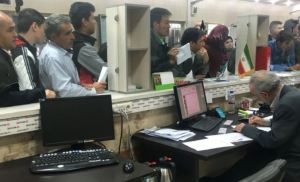nsnbc : The Iranian government forced nearly 130,000 undocumented Afghan refugees to return this year and aims at returning about 600,000 by the end of 2017. With Afghan government services having problem coping with the large influx, most are heading to an uncertain future in Afghanistan where the resurgent Taliban is now controlling about 40 percent of rural territories in the country.
 Hafiz Ahmad Miakhel, spokesman for the Afghanistan Ministry of Refugees and Returnees said “Last week, 7,695 Afghan refugees returned from Iran, 60-65 percent of whom were deported involuntarily. … The majority of them were young individuals, but some were families, including women and children.” Ironically, Iranian State-media like PRESS TV would largely ignore the wave of expulsions and rather focus on the occasional deportation of small groups of Afghans from European countries – so much to the function of State-funded media.
Hafiz Ahmad Miakhel, spokesman for the Afghanistan Ministry of Refugees and Returnees said “Last week, 7,695 Afghan refugees returned from Iran, 60-65 percent of whom were deported involuntarily. … The majority of them were young individuals, but some were families, including women and children.” Ironically, Iranian State-media like PRESS TV would largely ignore the wave of expulsions and rather focus on the occasional deportation of small groups of Afghans from European countries – so much to the function of State-funded media.
The government in Kabul stresses that the unprecedented influx of returnees has strained post-arrival services by the government and refugee agencies, especially with Pakistan also sending Afghan refugees home. The swelling numbers of deportees from Iran and high unemployment in Afghanistan lead to concerns that some of young returnees may join the Taliban or other militant groups. The large influx may also fuel a rising crime rate in a country already shaky from terror attacks and a high death rate among the security forces.
The Afghan government estimates that about two million Afghans are living in Iran. Most settled there after fleeing decades of war and conflict in their homeland. About 950,000 are classified as refugees. Mikhael told reporters that “Of the 440,000 Afghan refugees who returned to Afghanistan from Iran last year, over 157,000 were deported, the majority of whom were young individuals who were residing illegally in Iran. … The involuntary deportation is a clear violation of bilateral and trilateral agreements,” he said.
Mikhael also noted that Iran has closed the main Islam Qala border crossing for the past few months for unspecified reasons, and refugees are returning through alternative border crossings, which lack facilities to accommodate high numbers. Consequently, more than 2,000 people crowd each day through Nirmorz’s Malik border crossing, “which cannot accommodate more than 1,000 people a day,” Miakhel said.
In November 2012, Iran issued regulations allowing police and custom authorities to expel about 1.6 million undocumented foreigners by the end of 2015. Since then, hundreds of thousands of Afghans have returned or deported from Iran. The International Organization for Migration (IOM)reported that the number of undocumented returnees from Iran since New Year’s Day was 127,935 through May 13.
Iran has allowed a large number of Afghans to stay in Iran legally. The vast majority of them is employed in low-income bracket jobs that most Iranians would avoid if they possibly can. The policy has also contributed to keeping salaries low in Iran. However, with unemployment growing in Iran and after wages have been undercut, pressure is mounting for most of them to be sent home too.
While in Iran, Afghan workers generally lack basic rights and access to economic opportunities. Rights groups have consistently accused the Iranian government of maltreating them. The violations, according to Human Rights Watch and other rights organizations, include “physical abuse, detention in unsanitary and inhumane conditions, forced payment for transportation and accommodation in deportation camps, forced labor, and forced separation of families.”
The rights group also stress that Iranian authorities deport Afghan refugees “summarily, without allowing them the opportunity to prove they have a right to remain in Iran, or to lodge an asylum application.” Some refugees claim arrests for no reason, particularly in Tehran. Police counter that most arrests are for involvement in the drug trade. The government in Kabul, for its part, says it is trying to facilitate voluntary repatriation of refugees from Iran and Pakistan as the “refugee issue is sometimes used as a leverage against Afghanistan.”
Iran has also recruited thousands of Afghan – Shia refugees to fight alongside forces of the Lebanese militant group Hezbollah and Iran’s elite Revolutionary Guard forces in support of the government of Syrian President Bashar al-Assad. Iran’s army recruits them with promises of Iranian citizenship and improved living standards for their families. Iranian President Hassan Rouhani last year promised the Chief Executive of Afghanistan Abdullah Abdullah to offer legal status to Afghan refugees instead of expelling them. However, according spokesperson Miakhel, Tehran has not yet executed a Memorandum of Understanding signed between the two countries two years ago.
CH/L – nsnbc 22.05.2017
Source Article from https://nsnbc.me/2017/05/22/iran-deported-nearly-130000-afghan-refugees-in-2017/
Related posts:
Views: 0
 RSS Feed
RSS Feed















 May 22nd, 2017
May 22nd, 2017  Awake Goy
Awake Goy 










 Posted in
Posted in  Tags:
Tags: 
















